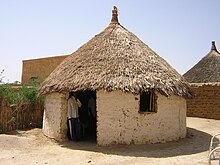

An earth structure is a building or other structure made largely from soil. Since soil is a widely available material, it has been used in construction since prehistory. It may be combined with other materials, compressed and/or baked to add strength.
Soil is still an economical material for many applications, and may have low environmental impact both during and after construction.
Earth structure materials may be as simple as mud, or mud mixed with straw to make cob. Sturdy dwellings may be also built from sod or turf. Soil may be stabilized by the addition of lime or cement, and may be compacted into rammed earth. Construction is faster with pre-formed adobe or mudbricks, compressed earth blocks, earthbags or fired clay bricks.[a]
Types of earth structure include earth shelters, where a dwelling is wholly or partly embedded in the ground or encased in soil. Native American earth lodges are examples. Wattle and daub houses use a "wattle" of poles interwoven with sticks to provide stability for mud walls. Sod houses were built on the northwest coast of Europe, and later by European settlers on the North American prairies. Adobe or mud-brick buildings are built around the world and include houses, apartment buildings, mosques and churches. Fujian Tulous are large fortified rammed earth buildings in southeastern China that shelter as many as 80 families. Other types of earth structure include mounds and pyramids used for religious purposes, levees, mechanically stabilized earth retaining walls, forts, trenches and embankment dams.
Cite error: There are <ref group=lower-alpha> tags or {{efn}} templates on this page, but the references will not show without a {{reflist|group=lower-alpha}} template or {{notelist}} template (see the help page).